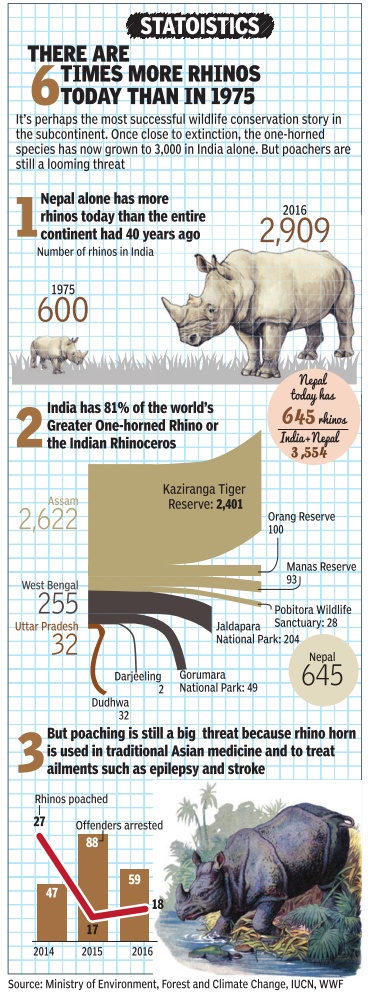Rhinoceros: South Asia
This is a collection of articles archived for the excellence of their content. |
Contents |
Rhinoceros population
2014-16
See graphic:
Rhinoceros in South Asia, statistics

2018: 2,413 rhinos in India
Rahul Karmakar, March 30, 2018: The Hindu
There is an increase of 12 rhinos from the 2015 estimate.
Kaziranga’s iconic one-horned rhino population has risen by 12 individuals. The latest headcount of the armour-plated herbivore in Assam’s world-famous reserve put the estimated number at 2,413 rhinos. This is an increase of a dozen over the 2015 figure.
After a review of the data, State wildlife officials said fewer rhinos may have been sighted this time due to the incomplete burning of tall grasses and reeds. This could be due to high moisture content. Burning of grasses is necessary for regeneration of low-lying vegetation in the 434 sq. km. park, a UNESCO World Heritage Site that also faces annual floods.
“We estimated the rhino population to be 2,413 after a two-day exercise that ended on Tuesday. This estimate, as with the census of the past, is plus or minus 100,” N.K. Vasu, the State’s Chief Wildlife Warden, said.
Gender unclear
Data released by the Assam Forest Department show that Kaziranga National Park now has 1,641 adult rhinos, of which 793 are females, 642 males and 206 ‘un-sexed’, which means the gender could not be ascertained. The number of sub-adult rhinos (four to six years old) was estimated to be 387, of which 149 are females, 116 males and 122 ‘un-sexed’. The calf count was 385. “Unlike past estimations, we had to deal with poor grass burning that could have led to under-counting. We could burn about 20% compared to normal mark of 60-70% every year,” Akashdeep Baruah, Director, KNP, told The Hindu. Kaziranga is the second of four habitats where the census was conducted. The first was at Pobitora Wildlife Sanctuary near Guwahati, where the count this time was 102, up from 93 in 2012.
The census at Manas National Park was over, and it would be done on April 2 in Orang National Park. Assam has an estimated 2,645 rhinos in all.
2022: Crosses the 4,000 mark
Prabin.Kalita, Sep 24, 2022: The Times of India
Guwahati : The population of the greater one-horned rhino, which is found only in India, Nepal and Bhutan, has crossed the 4,000-mark by registering a 167% rise in the last 42 years, scri pting a wonderful conservation success story.
This was revealed in the 2022 ‘State of Rhino’ report of the International Rhino Foundation released on the eve of World Rhino Day obse rved on September 22. The WWF states that the greater one-horned rhinos were very close to extinction and by the beginning of the 20th century, there were only around 200 of them. There are five rhino primary species — greater one-horned rhino, Sumatran rhino, Javan rhino, black rhino, and white rhino.
According to the report, the world’slast remaining populatio n of Javan rhinos remained stable but faced threats, including from human encroachment and insufficient habitat, while experts estimated a 13% decline for Sumatran rhinos. On the other hand, Africa’s white r hino population continued to decline under pressure from poaching. However, the count of black rhinos is growing across Africa.
The report said that the Asian Rhino Specialist Group has announced that the population of the greater onehorned rhino has increased to 4,014, after a biannual survey completed in early 2022, and attributed the growth “largely due to the governments of India and Nepal creating habitats for rhinos, while also preventing poaching”.
“Poaching remains a threat, but authorities in India have had great success in significantly reducing it through intense security and strict enforcement of wildlife crime laws. In 2021, there was only one recorded poaching incide nt. There has been only one recorded incident in the first half of 2022 as well. ”
Of these greater one-horned rhinos, over 80% are in India with majority of them (2,613) being Kazi ranga National Park of Assam.
Threats
Assam
Rahul Karmakar, ‘Rhino habitat under threat of mining’, June 23, 2018: The Hindu
Outlining the threat posed to the rhino habitat, also a tiger reserve, environmentalist and RTI activist Rohit Choudhury has complained about the non-implementation of the recommendations of the National Tiger Conservation Authority (NTCA) by the Assam government for stopping all mining, quarrying and stone crushing activities in the Kaziranga-Karbi Anglong landscape.
‘NTCA ignored’
“The NTCA had in its report on April 20 asked the State government to immediately stop such activities that are severely hampering the survival and conservation of the tiger, its habitats, co-predators, prey, including mega herbivores, and their transit routes during the annual flood season,” Mr. Choudhury said on Saturday.
During floods, animals of low-lying Kaziranga National Park flee to the adjoining kills of Karbi Anglong district. Some stone mines and quarries are on their transit routes. “The NTCA found that stone mining/quarrying and stone crushers in the area between Kaziranga and the Karbi Anglong hills are responsible for the destruction of wildlife corridors and vital wildlife habitat essential for long ranging species like Indian elephants and tigers. In addition, these stone mining/quarrying and stone crushers are also responsible for drying up and siltation of several natural streams and rivulets flowing from the Karbi Anglong hills towards Kaziranga,” Mr. Choudhury wrote in his letter.
The Assam government, he said, has shown “complete disregard” to the NTCA’s recommendations.
Accusing the State Forest Department of corruption, Mr. Choudhury sought action from the Union Ministry.